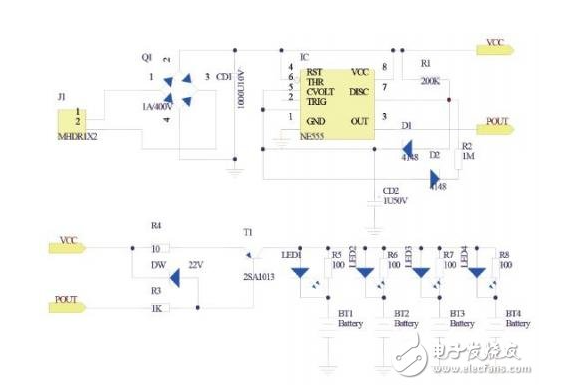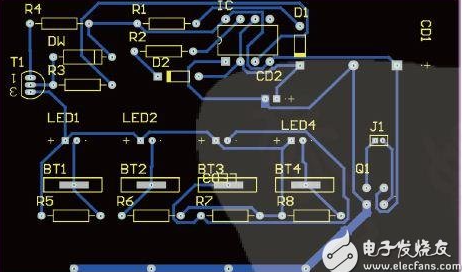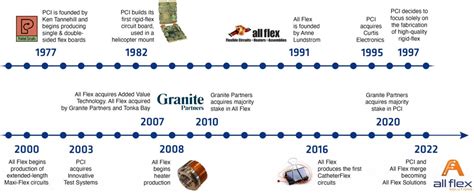Battery charger circuit design and PCB
1 Introduction to Protel software
With the rapid development of electronic information technology, the manual design of PCB (printed circuit board) of electronic products can no longer meet the needs of the development of electronic technology. We must use computers to complete the design of PCB, which is not only fast and accurate, but also can greatly reduce the labor intensity of engineering and technical personnel. There are many kinds of software involved, and Protel is one of the more classic ones.
Protel is a circuit-aided design system launched by Altium. It is the first board-level design system that integrates all design tools, including schematic design, PCB design, circuit simulation, PLD design, etc. Its earliest version was the TANGO software package, which later developed into Protel for DOS, Protel for Windows, Protel 98, Protel 99 SE, Protel DXP and Protel 2004. With the continuous upgrade of versions, its functions are becoming more and more powerful.
Compared with other versions, Protel 2004 has added many new functions, making the operation simpler and more automated, so that we can easily carry out various complex circuit board designs.
2 PCB Design
PCB is the abbreviation of Printed Circuit Board, translated as printed circuit board, referred to as circuit board or PCB board. Printed circuit board is made of conductive lines and component packages by printing. Its main function is to realize the fixed installation of electronic components and the electrical connection between pins, so as to realize various specific functions of electrical appliances. Making correct, reliable and beautiful printed circuit boards is the ultimate goal of circuit board design.
The general process of PCB design includes: pre-production preparation, making PCB component pin packages, creating new PCB files, planning circuit boards, loading component pin packages and networks, layout, wiring, DRC design rule checking, etc.
3 Ni-MH battery charger PCB design
Ni-MH battery charger is a common electronic product in our lives. The basic steps of designing the printed circuit board (PCB) of this circuit with Protel 2004 are as follows.
3.1 Create project files
To facilitate the management of various design files and the seamless connection and synchronous design between them. In Protel 2004, project files are used for management. First, create a project file, and then create or add various design files under the project file.
3.2 Create schematic file and complete the schematic design of battery charger circuit
The schematic diagram of Ni-MH battery charger circuit is shown in Figure 1 below.

Figure 1 Battery charger schematic
3.3 Create PCB file and plan
There are two ways to create PCB file in Protel 2004: create with file menu and create with wizard. It should be noted that the PCB file created with wizard is not in the project file. After creation, it must be placed in the project file, otherwise the following steps cannot be performed. According to the composition of the charger circuit, first plan the shape of the board to be rectangular, and determine the size of the board to be 2400mil×1300mil according to the number of components. Single-layer wiring is designed as a single-sided board.
3.4 Load component pin package and network and layout components
All components in this circuit are in socket package form. Except for the positive polarity package of the battery pack, the other component packages all use the standard package in the Protel 2004 component library. We need to set the package for the positive polarity of the battery pack according to the actual circuit. First, create your own component package library, create the package shown in Figure 2 as BT1-BT4 in the library, and then set this package as the package of the battery pack.

Figure 2 Battery charger PCB diagram
Component layout can be carried out by first automatic layout and then manual adjustment. Note that the transformer is not placed on this board. When laying out, pay attention to the reasonable and uniform arrangement and distribution of components, and strive to be neat, beautiful, and meet the requirements of circuit structure process.
3.5 Set wiring rules and carry out wiring
The so-called “wiring” is to use printed wires to complete the connection relationship of each component in the schematic diagram. After completing the component layout of any circuit board, the next thing to do is to connect the components with wires to make them have electrical characteristics, thereby forming a complete circuit board.
When wiring in Protel 2004, you must first set the wiring rules to meet electrical requirements such as safety principles. According to the actual requirements of the charger circuit, the safety spacing is set to 10mil, the top wiring, the ordinary line width is 10mil, the power line is 20mil, and the ground line is 30mil. The wiring adopts automatic wiring, and the places that do not meet the requirements can be manually modified. When wiring, under the premise of meeting the electrical requirements such as safety principles, the wires should be streamlined, as short as possible, with as few turns as possible, and strive to make the wires simple and clear.
In addition, the wiring design should consider whether the assembly is convenient, etc. Finally, the board is also required to be beautiful and economical. A good PCB board has beautiful wiring and fine workmanship, and looks like a work of art.
3.6 DRC design rule check and error elimination.
After the circuit board design is completed, in order to ensure that the design work meets the requirements, the computer can automatically complete the inspection work, that is, the DRC design rule check. After the inspection is completed, the system will pop up the Messages information box. According to this information prompt, modify the design until there is no error. At this point, the PCB design work of the circuit is completed, and the designed charger PCB file is shown in Figure 2 above. Finally, you can print out drawings and reports, and carry out corresponding follow-up work such as actual board making.
4 Summary
Using Protel 2004 software for PCB design is simple to operate and highly automated. Ni-MH battery charger PCB design has the commonality of PCB design and also has certain characteristics. To design a perfect charger PCB, a lot of experience accumulation is needed. With the development of electronic technology, electronic circuits are becoming more and more complex, requiring designers to continuously improve their design level and design more PCB products.






